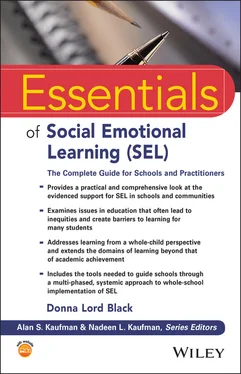Donna Lord Black - Essentials of Social Emotional Learning (SEL)
Здесь есть возможность читать онлайн «Donna Lord Black - Essentials of Social Emotional Learning (SEL)» — ознакомительный отрывок электронной книги совершенно бесплатно, а после прочтения отрывка купить полную версию. В некоторых случаях можно слушать аудио, скачать через торрент в формате fb2 и присутствует краткое содержание. Жанр: unrecognised, на английском языке. Описание произведения, (предисловие) а так же отзывы посетителей доступны на портале библиотеки ЛибКат.
- Название:Essentials of Social Emotional Learning (SEL)
- Автор:
- Жанр:
- Год:неизвестен
- ISBN:нет данных
- Рейтинг книги:5 / 5. Голосов: 1
-
Избранное:Добавить в избранное
- Отзывы:
-
Ваша оценка:
- 100
- 1
- 2
- 3
- 4
- 5
Essentials of Social Emotional Learning (SEL): краткое содержание, описание и аннотация
Предлагаем к чтению аннотацию, описание, краткое содержание или предисловие (зависит от того, что написал сам автор книги «Essentials of Social Emotional Learning (SEL)»). Если вы не нашли необходимую информацию о книге — напишите в комментариях, мы постараемся отыскать её.
Essentials of Social Emotional Learning (SEL): The Complete Guide for Schools and Practitioners
Essentials of Social Emotional Learning (SEL)
Essentials of Emotional Learning (SEL
Essentials of Social Emotional Learning (SEL) — читать онлайн ознакомительный отрывок
Ниже представлен текст книги, разбитый по страницам. Система сохранения места последней прочитанной страницы, позволяет с удобством читать онлайн бесплатно книгу «Essentials of Social Emotional Learning (SEL)», без необходимости каждый раз заново искать на чём Вы остановились. Поставьте закладку, и сможете в любой момент перейти на страницу, на которой закончили чтение.
Интервал:
Закладка:
Rapid Reference 2.1
Inflammatory Syndrome in Young People Linked to COVID‐19
Although adults (especially older adults) were thought to be at greater risk for contracting the virus, it quickly became evident that children and youth were not immune. Clusters of children began to emerge with a COVID‐19‐linked illness called pediatric multisystem inflammatory syndrome (PMIS). This syndrome resembled a rare inflammatory illness very similar to Kawasaki disease, but manifested differently because children and youth exhibited a higher degree of physical shock, akin to toxic shock syndrome. While the COVID‐19 virus was primarily a respiratory disease in adults, PMIS was known to affect the organs and blood vessels in children and youth.
Medical experts were not sure that PMIS was caused by the virus, but they were sure that there was a relationship between the two. Many of the children and youth who were diagnosed with PMIS were found to also carry the COVID‐19 virus, and a significant number of these children and youth had been exposed to a person infected by COVID‐19. The first U.S. cases of PMIS emerged in New York, about a month after a surge of COVID‐19 infections were reported in that region, but cases were also reported in England, one of which resulted in death (MacMillan, 2020).
Of the total number of COVID‐19 cases reported in the United States, only 2 percent of those cases were reported in children and youth, and they ranged in age from infants to teenagers (Melillo, 2020). Thus, as more cases of PMIS began to emerge, concerns for children’s and youth’s physical health increased among parents and healthcare providers and added to the challenges of returning children to school and childcare facilities.
The growing concerns for the physical safety of children and youth further compounded the existing worries over their social, emotional, and mental well‐being, leaving parents and experts to grapple over how to maintain physical safety without sacrificing their need for social and emotional development and their mental health. This dilemma was the basis behind every decision being faced by parents, educators, schools, and childcare providers as recovery efforts began. The discussion that follows will focus on that perspective and the resulting outgrowth of SEL as awareness grew.
As the disastrous effects of the pandemic grew clearer, so did the long‐term implications. One of the most significant concerns, as noted, was the lasting impact it might have on children and youth in relation to their social, emotional, and mental well‐being. Parents and children alike struggled to cope with the pandemic’s upheaval on their lives, but for many, the effects of sheltering in place and social isolation left them with feelings of emotional despair. Parents and educators grappled with distance learning, and for some students, educational experiences were grossly inequitable. For many families, the economic devastation caused by the pandemic meant the loss of jobs and an accompanying loss of income, which worsened the distress caused by the situation. For those who were already without jobs and a source of income, or living at a poverty level, the impact was completely devastating.
Though the COVID‐19 pandemic was felt by generations of people, history has shown that disasters typically have a greater psychological impact on children than they do on adults. However, the impact can vary by age, environmental conditions, exposure to the disaster, and levels of support from parents and other adults. If parents or adult caretakers of children also suffer from distress or a mental illness, the psychological impact is greater for these children (Fothergill, 2017). Indeed, studies have shown that parental distress is sometimes the strongest predictor of their children’s distress (Norris, Friedman, & Watson, 2002, p. 237). So, while there is a widespread assumption that children have great resiliency and will simply bounce back from a disaster, this is true only if they receive proper care and supports.
The children and youth of the COVID‐19 pandemic, like other children and youth who have experienced disasters, were trauma impacted. As they became more and more isolated from one another, they struggled to cope, both emotionally and behaviorally, and a corresponding need for supports grew. At the outset of the quarantine, there was an unprecedented demand for information on social and emotional development, and it was unlike anything SEL advocates had witnessed prior to the pandemic. A plethora of resources began to surface on the internet and through social media, and although most of these were made available to the general public at no cost, accessibility was a barrier for many. As the awareness and need for SEL grew and became more distinct, so did concerns and questions. School leaders and educators voiced growing concerns for how these trauma‐impacted children would be supported when they returned to schools. They began advocating for SEL as a viable approach, and discussions about how to effectively support these students became part of the critical debate on school re‐openings. In addition, it became increasingly clear that school staff would need training in trauma‐informed practices so they could better meet the needs of the children when they returned. More interestingly, school leaders were concerned with how staff would adjust to school re‐entry and what supports they might need, having been trauma impacted themselves.
After several months of quarantine and in the weeks leading up to a lifting of the quarantine, communities began examining the re‐opening of schools. This became an enormous undertaking because there was still so much that was unknown about the virus (primarily because of a limited amount of scientific data). Consequently, plans had to include multiple options and various requirements, such as allowing physical distance among and between staff and students, equipping schools to maintain safe and sanitized environments, and equipping school health staff with appropriate healthcare supplies and personal protective equipment. As schools began exploring these options, they also recognized that there might be accompanying ripple effects. For example, the limitations of the physical‐distancing requirement might mean that not all students could return to a full school schedule, which might subsequently mean inequitable opportunities for some students. There were various consequences for each potential scenario, and each was of concern.
Despite these issues and given the ongoing uncertainty surrounding the virus (e.g., potential for a second outbreak), there remained a significant amount of doubt and hesitation regarding how and when students should return to school. One thing was certain, however: Whenever they returned, the need for staff and student supports would be immediate and intense. Concurrent concerns about academic growth were equally disturbing, and the debate over which would take precedence ensued, as illustrated in Rapid Reference 2.2.
Influence of Exclusionary Discipline Practices on School Safety
Prior to the pandemic of 2020, school shootings, bullying, and other school safety issues had risen to the forefront of concerns by parents, educators, community members, and policy makers. With the onset of the pandemic and the subsequent closings of schools, concerns naturally shifted away from these issues. However, this shift was likely only temporary. This section will explore how school discipline practices influenced school safety and how this, in turn, led to an increased awareness of the need for SEL.
Rapid Reference 2.2
The following blog was posted on May 7, 2020, as pandemic recovery efforts were just beginning. The blog provides an example of how fears for students’ academic regression might take precedence over their need for SEL supports when addressing policy and funding for schools. The fear that SEL might become the sacrificial lamb to the budget was a very real and pervasive concern .
Читать дальшеИнтервал:
Закладка:
Похожие книги на «Essentials of Social Emotional Learning (SEL)»
Представляем Вашему вниманию похожие книги на «Essentials of Social Emotional Learning (SEL)» списком для выбора. Мы отобрали схожую по названию и смыслу литературу в надежде предоставить читателям больше вариантов отыскать новые, интересные, ещё непрочитанные произведения.
Обсуждение, отзывы о книге «Essentials of Social Emotional Learning (SEL)» и просто собственные мнения читателей. Оставьте ваши комментарии, напишите, что Вы думаете о произведении, его смысле или главных героях. Укажите что конкретно понравилось, а что нет, и почему Вы так считаете.












